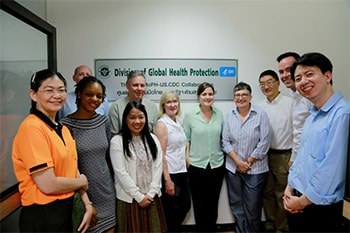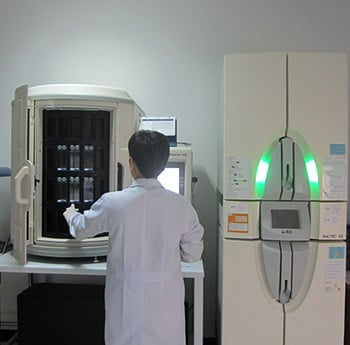Better Tests, Better Surveillance: On the Cutting Edge Of Laboratory Innovation in Thailand
July 25, 2018
The new diagnostic tool “… makes us more knowledgeable about pathogens that cause disease and helps show trends of antibiotic resistance. Our public health officers and physicians use this information to prevent and control bacterial diseases.”
— Possawat Jorakate, Senior Medical Technologist, Strengthening Laboratory Capacity Program, Nonthaburi Thailand
In today’s interconnected world, deadly diseases can spread swiftly, underscoring the need for innovative, accurate, real-time lab results to stop an epidemic in a moment’s notice.
Through laboratory innovation, Thailand is advancing their public health system to better protect and save lives.
One hospital, Nakhon Phanom Provincial in Thailand, is leading the way in lab innovation and inspiring others to install a new lab instrument that streamlines pathogen identification and antimicrobial resistance testing. This is great news for the hospital that is home to a national surveillance lab, which detects and controls disease outbreaks to protect more than 750,000 lives in 12 districts.
Working together, CDC’s Global Disease Detection (GDD) Regional Center in Thailand and the Thai Ministry of Public Health jointly manage the lab that installed the new technology in January 2016.
Revolutionizing Disease Detection in Thailand

Dr. Toni Whistler, fourth from the right, with the Thailand lab staff at the surveillance lab at Nakhon Phanom Provincial Hospital.
Before the new equipment arrived, the lab used time-consuming, manual methods to identify pathogens and test for antimicrobial resistance—which is what happens when medications become less able to cure an infection caused by a microorganism or “superbug.”
The new, automatic system identifies a pathogen and determines if it is antimicrobial resistant. It takes minimal staff effort, provides greater accuracy, and doubles the number of tests the lab can run, while shortening the time it takes by 12 hours. The system has cut lab testing costs in half and has reduced the staff’s workload by one third, showing that the investment is paying off.
The instrument has increased the lab’s capacity—identifying 48 pathogens to date, and distinguishing organisms from 430 more species—neither of which was possible with the lab’s previous manual testing methods.
Leading to New Opportunities

Scientist using the new laboratory system. It is a state-of-the-art, automated instrument which is faster than conventional, manual methods.
The lab system can’t identify some pathogens that are specific to Thailand since it was developed for use in western countries. The Nakhon Phanom lab is providing data to expand the instrument’s ability to recognize more pathogens, including Burkholderia pseudomallei—a bacteria common in Thailand that causes a dangerous disease known as melioidosis, or Whitmore’s disease, in humans and animals.
Following in the steps of Nakhon Phanom, one other hospital recently installed the lab system, and four more are seeking to acquire it. All these efforts are improving Thailand’s ability to prevent, detect, and respond to deadly pathogens to protect it and the world.
About This Story
Local Nakhon Phanom national surveillance lab staff led the project, in partnership with DGHP Nakhon Phanom’s Strengthening Laboratory Capacity Program, Nakhon Phanom Provincial Hospital, and the Nakhon Phanom Public Health Office.